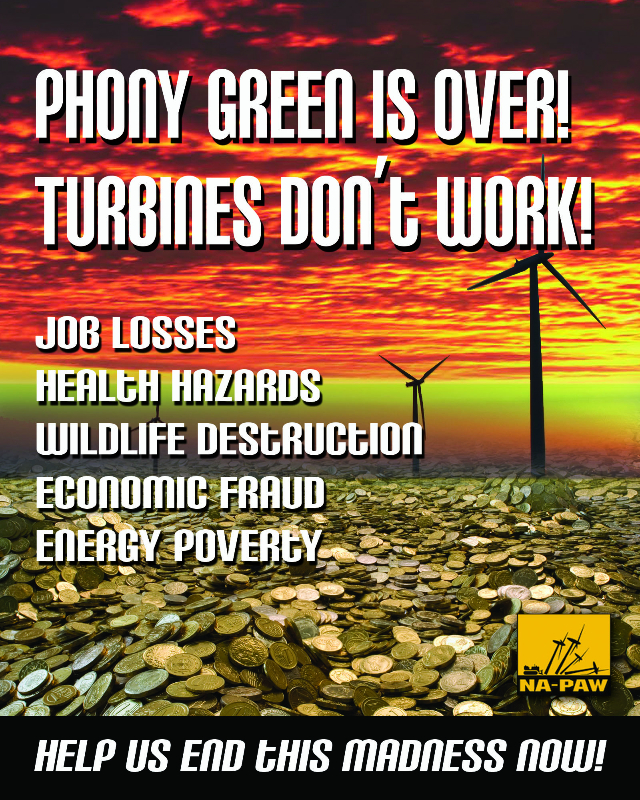
By Jon Boone — July 2, 2012
“Let’s stop politicalizing our electricity supply. Let’s eliminate all tax credits for energy production. Let’s require that utility scale generators produce firm, dispatchable capacity, and eliminate those that don’t.
Let’s demand that electricity grids and their regulators provide abundant highly reliable and secure electricity consistent with the most informed notions of public health. Abundant electricity will offer consumers real choice, resulting in lower prices and increased value.”
The most recent effort by those seeking profit from “green energy” evidently presumes that rate and taxpayers, if not most of the country’s citizenry, were born yesterday. Which made me think of Billie Dawn’s wicked malaprop in the movie classic, Born Yesterday: “This country and its institutions belong to the people who inhibit it.”
Few initiatives better illustrate how the nation’s future is being seized by those who would inhibit it than last week’s plea to “stop politicizing green energy.” In the best black/white Owellian tradition, a rump organization calling itself the US Partnership for Renewable Energy Finance, or US PREF (Google search finds little), claims that renewables are being demonized by wrong-thinking politicians at the expense of the country’s progressive future.
Feigning disinterest, the group offers a number of white papers purporting to show “how crucial renewable energy is as part of the nation’s overall energy mix,” “dramatically” reducing energy costs, bolstering national security, improving the environment, and producing long term jobs. US PREF lauded the role of long-standing Congressional production and energy tax credits as they work together with large scale state renewable energy portfolio laws to increase mainly wind and solar installations throughout the land.
These reports come to demonstrably wrong conclusions. In fact, US PREF’s premise is oxymoronic, given that wind and solar exist almost solely because the electricity sector has become highly politicized over the last thirty years, a process abetted by
– careless journalists;
– irresponsible economists;
– captured regulators;
– engineers more interested in make work than they are in maintaining the highest standards of their profession; and
– profiteering investment groups, including Morgan Stanley, Goldman Sachs, Citibank Credit Suisse, and virtually all of the Big Energy corporations.
Together they have successfully cultivated the idea that electricity is a scarce resource in need of continual husbanding–and that renewables can help replenish the diminishing stores of electrical energy supply.
In short, US PREF is yet another advocacy operation designed to separate the public from its wallet while reducing its quality of life. Let’s examine how.
FOUR FACTS for US PREF
First, when US PREF casually discusses “energy,” what it really means is energy converted to produce electricity. It is silent about the other 60% of the nation’s energy use harnessed to provide heating and transportation. People should not be confused by the way the term energy is bandied about by such lobbyists. Renewables are almost wholly about electricity production, not how society moves, warms itself, or feeds its livestock, primarily because of oil.
Second, the only widely effective source of renewable power is hydro, particularly large reservoirs of impounded water. But the typical inventory of “approved renewables excludes impounded hydro. As I have written previously:
Biofuels, led by corn ethanol [and buttressed by such fare as reprocessed human and animal waste], degrade the soil, increase the price of food, and expand our carbon footprint. Geothermal is limited in range while large-scale excavation would have serious environmental implications. Even hydro, the technology that exemplified renewable success for much of the last century, has come up against both the rock of limited access and the hard place of environmentalism, since building huge impoundment reservoirs degrades millions of acres of sensitive wetlands habitat. Which is largely why it is not included as a player in contemporary renewables schemes.
Because their construction can proceed relatively quickly, wind projects comprise between 75–90% of most renewable portfolios.
Third, with more informed journalism, the public might better understand how contemporary machines vastly improve productivity by converting high energy densities into time saving power. Wind machines can achieve no modern power because they must rely upon dilute hit or miss “found” energy that is both inimical to demand cycles and difficult to reconcile with conventional, highly controllable and dispatchable machines that do all the productive work. As a consequence, wind machines significantly reduce productivity. And increase cost–and price. Imagine that government mandated that 20% of all air transport be in the form of gliders, which is what it is doing in the electricity sector.
Fourth, levelized cost estimates generally give wind and solar, those renewables of choice, such a makeover that they become a fictional character in US PREF’s promotional narrative success story. Such estimates don’t account for the extensive factors enabling, say, wind integration, such as entangled conventional generation used to smooth out wind’s continuous variability, the building of substantial and virtually dedicated transmission lines, and the augmentation of new voltage regulation networks.
Even more curiously, they don’t consider crucial issues of value. Credible economic analysis must explain how costs bear on price as they dovetail to provide value.
Perhaps the best way to clarify this issue of value is to ask how much people would pay for the cost of machines that rarely work when asked, that work best in the wee hours of the morning, and surge up and back even when they are working “normally.” Thinking that such performance has value in terms of modern expectations for machine behavior is burlesque economics, deserving of scornful parody.
The country has lemon laws to protect the public from such defective machines. US PREF asks that government protect the renewables portfolios against those lemon laws, since wind especially behaves just like a defective machine when it is performing as expected–and solar is not much better.
Policy Fail
I could endlessly enumerate why renewables as a class of energy providers cannot achieve the goals US PREF claims for them. Their huge physical footprint assaults any rational concept of informed environmentalism. Their need for large scale and continuous supplementation increases costs and price. Their raggedy performance decreases the quality of the electricity supply, in the process also reducing its quantity.
It should come as no surprise to learn that US CREF is mainly a creature of investment groups seeking to extend government subsidies so that the favored renewables, wind and solar, can continue–and expand upon–their real function as a mechanism to generate income via tax avoidance.
Using the tax code to bilk billions from millions with no performance accountability or even transparency is the very apotheosis of politicalized policy wrought by highly interested and vested capital. Some would even call it criminal if not for how the politics of renewables continues to craft laws enabling, legitimatizing, bunco, which is the craft of promising much and delivering nothing.
Billie Dawn also had the good sense to observe that “when you steal from the government, you’re stealing from yourself….” US PREF’s attempt to “inhibit” the nation’s federal treasury is rivaled only by its Orwellian perversity about what is political.
Conclusion
Despite US PREF’s attempt to rewrite history, those who weren’t born yesterday are not condemned to repeat it.
Yes, let’s stop politicalizing our electricity supply.
Let’s eliminate all tax credits for energy production. Let’s require that utility scale generators produce firm, dispatchable capacity, and eliminate those that don’t.
Let’s demand that electricity grids and their regulators provide abundant highly reliable and secure electricity consistent with the most informed notions of public health. Abundant electricity will offer consumers real choice, resulting in lower prices and increased value.




